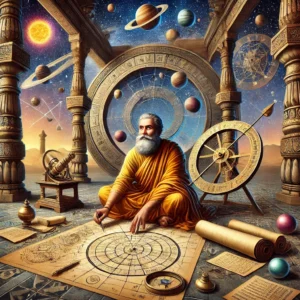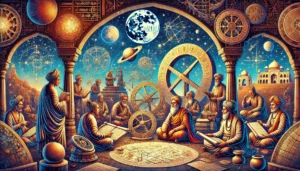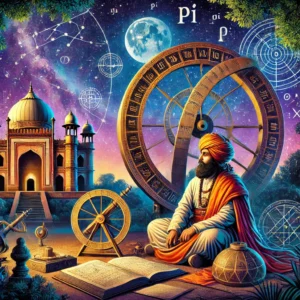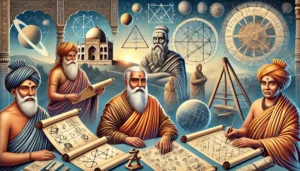
History of mathematics in ancient India
Contributions of Ancient India to Astronomy and Mathematics
India’s rich history of intellectual pursuits has been a cornerstone of the world’s scientific progress, particularly in astronomy and mathematics. Ancient Indian scholars made groundbreaking discoveries and developed sophisticated theories that continue to influence modern science and mathematics. From the invention of zero to the formulation of astronomical models, India’s contributions remain unparalleled. This article explores these advancements in detail, illustrating the brilliance of ancient Indian intellect.
The Foundations of Indian Astronomy
Astronomy in India can be traced back to the Vedic period (1500–500 BCE). The Vedas, particularly the Rigveda, contain references to celestial bodies and their movements. Early Indians observed the skies meticulously, associating astronomical phenomena with seasons, rituals, and timekeeping.
Vedanga Jyotisha
The first systematic treatise on astronomy was the Vedanga Jyotisha (circa 1200 BCE). It was a guide to timing rituals based on the positions of celestial bodies. This text introduced basic concepts of time measurement, lunar months, solar years, and intercalation (adjusting the calendar for alignment with astronomical observations).
Surya Siddhanta
The Surya Siddhanta, one of the oldest texts on Indian astronomy (circa 400 CE), is a landmark contribution. It detailed:
Planetary positions and orbits: The text provided formulas to calculate the movements of planets.
Trigonometry: It introduced sine tables for astronomical calculations.
Eclipses: The Surya Siddhanta offered explanations for solar and lunar eclipses, rooted in a heliocentric understanding of the solar system.
Table of Contents

History of mathematics in ancient India
Pioneers of Indian Astronomy
Aryabhata
Aryabhata (476 CE), one of India’s greatest astronomers and mathematicians, wrote the Aryabhatiya, a foundational text in both fields. His contributions include:
Earth’s rotation: He proposed that the Earth rotates on its axis, explaining the apparent motion of stars.
Eclipse theory: He rejected superstitions and explained eclipses as the shadow of Earth or the Moon.
Planetary models: He calculated the sidereal year with remarkable accuracy (365.2588 days).
Brahmagupta
Brahmagupta (598–668 CE) advanced Aryabhata’s work and wrote the Brahmasphutasiddhanta, a treatise blending astronomy and mathematics. His astronomical contributions include:
Gravity: He speculated about gravitational force centuries before Newton.
Accurate calculations: He refined planetary calculations and provided tables for predicting celestial events.
Contributions to Mathematics
Ancient Indian mathematicians made significant strides, laying the groundwork for modern mathematics.
The Invention of Zero
The concept of zero as both a numeral and a placeholder is one of India’s greatest gifts to humanity. The first recorded use of zero dates to the 5th century CE in the work of Aryabhata. This revolutionary concept transformed arithmetic and made advanced calculations possible.
Decimal System
India developed the decimal numeral system, which was later transmitted to the Islamic world and Europe. The positional notation system (using powers of ten) enabled the representation of large numbers and simplified calculations.
Geometry and Algebra
Indian mathematicians excelled in geometry and algebra, solving problems with ingenuity.
Sulbasutras (800–500 BCE): Ancient texts on geometry, used for constructing sacrificial altars, contain Pythagorean triples predating Pythagoras.
Brahmagupta: He solved quadratic equations and introduced methods for handling negative numbers and zero in equations.
Trigonometry
Indian astronomers were pioneers in trigonometry, using it to calculate planetary positions and distances. The Surya Siddhanta and Aryabhata’s works introduced sine functions and their tables, which formed the basis of modern trigonometry.

History of mathematics in ancient India
Interdisciplinary Applications
The synergy between astronomy and mathematics in ancient India resulted in practical applications, such as:
Calendars: Accurate calendars based on lunar and solar cycles, still used in Hindu traditions.
Navigation: Indian sailors used astronomical observations for sea navigation.
Timekeeping: Advanced water clocks and shadow clocks were developed to measure time precisely.
Influence on the World
The contributions of ancient India were not confined to its borders. Through trade, travel, and scholarly exchanges, Indian knowledge spread across the world.
Islamic World: Indian mathematics and astronomy profoundly influenced Islamic scholars during the medieval period. For instance, Al-Khwarizmi’s algebra was based on Indian numeral systems.
Europe: Indian ideas entered Europe during the Renaissance, fueling scientific progress. Fibonacci, for example, popularized Indian numerals in the West.
Legacy of Ancient Indian Scholars
Indian intellectuals like Bhaskara I, Varahamihira, and Madhava of Sangamagrama continued to build on their predecessors’ work.
Varahamihira: His work, the Panchasiddhantika, compiled five astronomical systems of his time, integrating them into a comprehensive framework.
Madhava: He pioneered infinite series in calculus, including approximations for pi.
Conclusion
The contributions of ancient India to astronomy and mathematics demonstrate the sophistication of its intellectual tradition. By harmonizing observation, calculation, and theory, Indian scholars unlocked secrets of the cosmos and laid the foundations for modern science. Today, these achievements remind us of the timelessness of knowledge and the importance of preserving our scientific heritage.
Through their brilliance, ancient Indian scholars not only solved contemporary problems but also provided humanity with tools to explore the universe and understand its fundamental principles. Their legacy continues to inspire and guide scientific thought worldwide.
FAQs on Contributions of Ancient India to Astronomy and Mathematics
1. What are the major contributions of Ancient India to astronomy?
Ancient India made several groundbreaking contributions to astronomy, many of which have influenced modern science. Some key contributions include:
Development of the concept of a heliocentric universe: Aryabhata (5th century CE) proposed that the Earth rotates on its axis and correctly explained the cause of eclipses.
Cataloging celestial objects: Ancient Indian astronomers recorded star positions and movements, contributing to the understanding of constellations.
Accurate calendars: Indian astronomers like Varahamihira developed lunisolar calendars, still relevant in modern times.
Calculation of planetary orbits: Indian astronomers precisely calculated planetary positions and movements.
Siddhantic texts: Works like Aryabhatiya and Surya Siddhanta offered foundational insights into planetary motion, eclipses, and timekeeping.

History of mathematics in ancient India
2. Who were the prominent ancient Indian astronomers?
Some of the most notable astronomers from ancient India include:
Aryabhata (476 CE): Known for his Aryabhatiya, he introduced the concepts of the Earth’s rotation, sidereal time, and an early heliocentric model.
Varahamihira (505–587 CE): Wrote Pancha Siddhantika, a compilation of earlier astronomical knowledge.
Brahmagupta (598–668 CE): Authored Brahmasphutasiddhanta, discussing planetary motion, eclipses, and innovative mathematical concepts.
Bhaskara I (7th century CE): Commented on Aryabhata’s works and enhanced trigonometric functions.
Bhaskara II (1114–1185 CE): Also known as Bhaskaracharya, he refined astronomical calculations in his Siddhanta Shiromani.
3. What mathematical concepts originated in ancient India?
Ancient India pioneered many mathematical concepts, including:
The concept of zero: The Indian mathematician Brahmagupta introduced the concept of zero as a number around 628 CE.
Decimal system: India developed the base-10 number system, which became the foundation of modern mathematics.
Algebra (Bijaganita): Indian mathematicians like Aryabhata and Bhaskara II contributed to algebraic equations and problem-solving techniques.
Trigonometry: The sine and cosine functions were first defined in Indian trigonometry as jya and kojya.
Pi (π): Aryabhata approximated the value of π as 3.1416, which was remarkably accurate for its time.
4. What is the significance of Aryabhata’s work in astronomy and mathematics?
Aryabhata’s contributions are monumental in both astronomy and mathematics. His work includes:
Earth’s rotation: He proposed that the Earth spins on its axis, explaining the apparent movement of celestial bodies.
Eclipses: Aryabhata correctly described the shadow-based nature of solar and lunar eclipses.
Pi (π): He calculated π to four decimal places (3.1416).
Trigonometry and algebra: Aryabhata introduced concepts of trigonometric functions and solved algebraic equations.
Measurement of time: His division of time into units (hours, minutes, and seconds) was precise and groundbreaking.
5. How did ancient Indian mathematicians contribute to algebra?
Indian mathematicians made significant strides in algebra (Bijaganita):
Solutions to quadratic equations: Brahmagupta provided general solutions to quadratic equations.
Early algebraic notations: Indian texts like Aryabhatiya used symbolic methods for expressing equations.
Arithmetic progression and series: Indian mathematicians extensively worked on arithmetic and geometric progressions.
6. What were the key contributions of Brahmagupta?
Brahmagupta, an influential mathematician and astronomer, contributed to:
Concept of zero: He formalized operations involving zero and introduced its use in equations.
Negative numbers: Brahmagupta was among the first to discuss negative numbers and their rules in arithmetic.
Astronomical calculations: His work in Brahmasphutasiddhanta addressed planetary motion and eclipses.
Geometry: He calculated the area of cyclic quadrilaterals and introduced formulas still used today.
7. What role did ancient India play in the development of trigonometry?
India is credited with significant developments in trigonometry:
Sine and cosine functions: Indian mathematicians defined and systematically used these functions.
Trigonometric tables: They created detailed sine tables for astronomical calculations.
Use in astronomy: Indian trigonometry was essential for predicting planetary positions, eclipses, and timekeeping.
8. How did Indian mathematics influence the Islamic Golden Age and Europe?
Indian mathematics reached the Islamic world and Europe through translations of Sanskrit texts into Arabic and Latin:
Arabic translations: Texts like Aryabhatiya and Brahmasphutasiddhanta were translated into Arabic (e.g., Al-Zij al-Sindhind).
Adoption of numerals: The Indian decimal system and numerals were introduced to Europe as “Arabic numerals.”
Foundation for advancements: Indian works on algebra, trigonometry, and geometry became stepping stones for Islamic and later European mathematicians.
9. What are the “Siddhantas,” and why are they important?
The Siddhantas are ancient Indian texts on astronomy, covering calculations, planetary motions, and timekeeping. Notable Siddhantas include:
Surya Siddhanta: A foundational work on celestial mechanics and timekeeping.
Aryabhatiya: Focuses on mathematics and astronomical theories.
Brahmasphutasiddhanta: Combines astronomy with advanced mathematical principles.
These texts formed the basis for further studies in Indian astronomy and influenced global scientific thought.
10. How did ancient Indian contributions impact modern science?
Ancient Indian achievements laid the groundwork for modern scientific disciplines:
Astronomy: Concepts like heliocentrism and precise astronomical calculations are integral to modern astrophysics.
Mathematics: The decimal system, algebra, and trigonometry underpin contemporary mathematics.
Calendars: Indian lunisolar calendars influenced timekeeping worldwide.
The transmission of these ideas through trade and translations enriched global knowledge systems.
11. What were the key astronomical instruments used in ancient India?
Ancient Indian astronomers used innovative instruments for observations and calculations:
Gnomons (shadow clocks): Used to measure time and solar altitudes.
Armillary spheres: Modeled celestial spheres and planetary positions.
Yantras: Devices like the Sundial Yantra and Samrat Yantra for precise astronomical readings.
12. Did ancient Indian contributions to astronomy include cosmology?
Yes, ancient Indian texts explored cosmological theories:
Cyclic time concept: Indian cosmology described time as cyclic, with recurring cosmic cycles (Yugas).
Multiverse theory: Some interpretations of Vedic texts suggest ideas akin to a multiverse.
Scale of time: Indian cosmology calculated vast time scales, such as the age of the Earth and universe.
13. What is the legacy of ancient Indian contributions to science?
The legacy of ancient India’s contributions is profound:
Global influence: Ideas from Indian astronomy and mathematics shaped Islamic, Chinese, and European sciences.
Foundational concepts: Modern mathematics, astrophysics, and cosmology build on ancient Indian principles.
Cultural pride: India’s advancements highlight the intellectual prowess of ancient civilizations.
Summary
Ancient India made remarkable contributions to the fields of astronomy and mathematics, influencing both modern science and global knowledge systems.
Mathematics
Concept of Zero: Indian mathematician Aryabhata is credited with formalizing the concept of zero as a numeral, which revolutionized arithmetic and algebra.
Decimal System: The Indian numeral system, including the use of the decimal base, became the foundation for modern mathematics.
Algebra: Indian mathematicians like Brahmagupta and Bhaskara made significant contributions to algebra, introducing methods to solve quadratic equations and theories on integers.
Geometry: Indian scholars provided early insights into geometry, including the construction of altars and religious spaces. The Sulbasutras contain detailed geometric rules and approximations for pi.
Trigonometry: Aryabhata and later Indian mathematicians introduced concepts of sine, cosine, and tangent, laying the groundwork for modern trigonometry.
Astronomy
Aryabhata’s Astronomical Model: Aryabhata proposed a heliocentric model where Earth rotates on its axis, and he accurately calculated the length of the solar year and planetary positions.
Sidereal and Lunar Calendars: Indian astronomers developed precise methods to calculate lunar and solar eclipses, as seen in the works of Varahamihira and Bhaskara II.
Observatories and Instruments: Instruments like the gnomon and armillary sphere were used for observations, and ancient texts like the Surya Siddhanta contain sophisticated models of planetary motion.
Cosmology: Indian cosmology introduced cyclic time concepts, with ideas of yugas and kalpas resembling modern theories of time and space.
These contributions not only shaped the subcontinent’s intellectual traditions but also influenced the Islamic Golden Age and later European advancements in science.
Related Articles
- The Tridevi: Lakshmi, Saraswati, and Parvati – Their Roles and Powers
- “Divine Creatures of Ancient Indian Scriptures: Exploring the Role of Animals in the Vedas, Puranas, and Mahabharata”
- Nature and Spirituality: Exploring the Sacred Essence of the Himalayas, Ganga, and Other Natural Wonders”
- “Reviving the Gurukul System: Relevance and Lessons for Modern Education”
- “Exploring Greek and Indian Mythology: Similarities Between Greek and Indian Mythology “
- “Embracing Sattvic Living: Harmonizing Mind, Body, and Soul Through Food and Lifestyle”
- “Charity and Prosperity: Exploring the Concept of Daan and Its Financial Relevance in Modern Life”
- How to Build an Eco-Friendly Home Inspired by Vastu Shastra
- Comparison of Ancient and Modern Sports: How Traditional Sports Have Influenced Contemporary Games
- “Timeless Lessons from Ancient Tales: Linking Samudra Manthan and Ganga’s Descent to Modern Ecological Challenges”
- “Reviving Sanskrit: How AI is Preserving Ancient Languages for the Future”
- “Mathura: The Sacred Land of Lord Krishna’s Divine Leelas”
- Investing for Future Generations: Lessons from Indian Traditions on Legacy Building and Wealth Preservation
- “Ancient Indian Wisdom: Timeless Lessons for Tackling Today’s Climate Crisis”
- “Artificial Intelligence and Spirituality: Transforming Ancient Practices for the Modern World”
- “Gold and Real Estate in India: Timeless Assets Shaping Financial Strategies”
- “Divine Feminine Power in Hindu Mythology: The Legends of Durga, Saraswati, and Lakshmi”
- “Divine Beings of Sanatan Dharma: The Spiritual Significance of Sacred Animals in Hinduism”
- “Symbolism in Mythological Art: Unlocking Hidden Meanings in Ancient Temple Carvings”
- “Exploring Technological Advancements in Ancient India and Civilizations: Vimana, Metallurgy, & Water Management systems”
- Unveiling the Mysteries: Ancient Temples of Sanatan Dharma , Mysterious Temples of India
- “The Scientific Knowledge of Sanatan Dharma: Ancient Wisdom Meets Modern Science”
- Ancient Indian Sports and Games: Celebrating a Legacy of Skill, Strength & Strategy”
- “Exploring the Cosmic Link: The Connection Between Astronomy and Vedic Astrology”
- The Power of Sanskrit: Unlocking the Divine Language of the Gods
- “The End of Kaliyuga: A Sanatan Insight into the World’s Final Chapter”
- Explore more articles on Prachin Sanatan Yuga.
History of mathematics in ancient India History of mathematics in ancient India History of mathematics in ancient India History of mathematics in ancient India History of mathematics in ancient India
History of mathematics in ancient India History of mathematics in ancient India History of mathematics in ancient India History of mathematics in ancient India History of mathematics in ancient India
History of mathematics in ancient India History of mathematics in ancient India History of mathematics in ancient India History of mathematics in ancient India History of mathematics in ancient India
History of mathematics in ancient India History of mathematics in ancient India History of mathematics in ancient India History of mathematics in ancient India History of mathematics in ancient India
History of mathematics in ancient India History of mathematics in ancient India History of mathematics in ancient India History of mathematics in ancient India History of mathematics in ancient India
